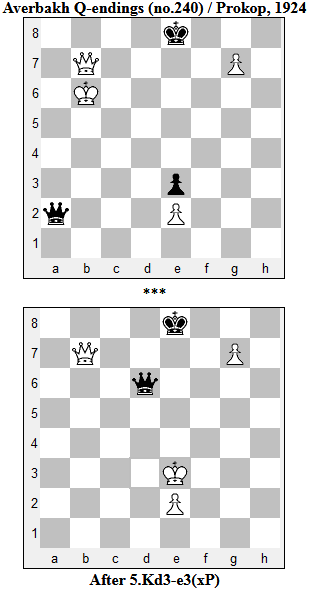A Flawed Seven-piece Study
In my previous post Seven-piece Tablebase on Lichess, I noted the 'first free 7-piece tablebase' and took the service for a test drive. The example that I used was from Averbakh's book on Queen endgames, specifically a section with four positions of the type Q+2P:Q+P where there are no passed Pawns. I ended the post saying,
I'll continue to look at other Q+2P:Q+P endgames and will post anything unusual that I find. I'll also look at other endgame sources to investigate the accuracy of their analysis.
The next section in Averbakh's book covers Q+2P:Q+P where the strong side has a passed Pawn. I fed all six examples to the Lichess tablebase and discovered that Averbakh's analysis was correct on five of them. The exception was a study by F.Prokop, shown in the top diagram, Black to move.

The study continued 1...Qb2+ 2.Kc5! (a temporary Queen sacrifice) 2...Qe5+(*) 3.Kc4 Qf4+(*) 4.Kd3 Qd6+(*) 5.Kxe3, arriving at the bottom diagram. Here the Averbakh/Prokop analysis continued with three candidate moves, all of which lead to a win for White. The most interesting for me is 5...Qg3+ 6.Qf3 Qg1+ 7.Kf4 Qh2+ 8.Kg4 Qg1+ 9.Kh3 Qxg7 10.Qa8+ Kf7 11.Qb7+ Kf6 12.Qxg7+ Kxg7 13.Kg4, because it shows a common theme in Q+P:Q endgames. The strong side trades Queens to arrive in a position with K+P:K, where the Kings are far apart and distant opposition plays a leading role. A similar idea is behind 2.Kc5!.
In the bottom diagram, the tablebase indicates a fourth move, 5...Qh6+, which it says is the only move leading to a draw. It appears that Black has a perpetual check with this move. The variations branch off into so many sub-variations, that it is impossible to follow all of the key moves. I'll just have to trust the tablebase on this.
In the main variation starting 1...Qb2+, what do the asterisks '(*)' mean? They identify moves that the tablebase indicates are the only move leading to a draw; other moves lose. The tablebase also says that there is an alternate solution in the diagrammed position: 1...Qe6+ also draws.
In a footnote, Averbakh indicated that the top diagram was in fact an intermediate position in Prokop's study, because the previous moves were flawed. With so many branching variations in Queen endgames, it's not surprising that both the original analysis and the subsequent correction were flawed.




No comments:
Post a Comment